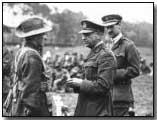Who's Who - Sir John Monash
 Sir John Monash (1865-1931) was born in
Melbourne on 27 June 1865 to parents of Prussian-Jewish origin and educated
at Scotch College and the University of Melbourne, where he studied law,
arts and engineering. Upon concluding his
university studies Monash developed an interest in the army, joining first
the Melbourne University company of the 4th Battalion, Victoria Militia, in
1884, and then the Melbourne University's Metropolitan Brigade of the
Garrison Artillery in 1887, rising to the rank of colonel in 1913.
Until the outbreak of war in 1914 Monash set himself the task of learning
the skills of artillery and engineering. He published, in 1913, an
army training manual entitled 100 Hints for Company Commanders.
Sir John Monash (1865-1931) was born in
Melbourne on 27 June 1865 to parents of Prussian-Jewish origin and educated
at Scotch College and the University of Melbourne, where he studied law,
arts and engineering. Upon concluding his
university studies Monash developed an interest in the army, joining first
the Melbourne University company of the 4th Battalion, Victoria Militia, in
1884, and then the Melbourne University's Metropolitan Brigade of the
Garrison Artillery in 1887, rising to the rank of colonel in 1913.
Until the outbreak of war in 1914 Monash set himself the task of learning
the skills of artillery and engineering. He published, in 1913, an
army training manual entitled 100 Hints for Company Commanders.
Once war was declared in 1914 Monash was appointed commander of the AIF's 4th Infantry Brigade based in Egypt at the age of 49 as part of the ANZAC Australian-New Zealand forces. Having served in the failed Gallipoli campaign in 1915, Monash transferred to the Western Front in June 1916, receiving a promotion to Major General and taking command of 3rd Division.
Through the next two years Monash led his command through numerous actions, including the Battles of Messines, 3rd Ypres and Polygon Wood, using pioneering raiding techniques that, whilst somewhat frowned upon by the British high command, nonetheless impressed with their efficiency and tight planning.
Monash made his real mark in 1918, having been earlier appointed corps commander of the Australian forces in May, succeeding General Birdwood. Until the armistice in November Monash led his forces through fierce fighting, firstly in the Allied defence against the great German push of spring 1918.
Monash planned and executed the attack at the Battle of Hamel Hill which began on 4 July, leading to the capture of the town by combined Australian and U.S. forces (during which he demonstrated to good effect his new strategy of 'peaceful penetration'). Other similarly successful operations followed until late October, at Chignes, Mont St. Quentin, Peronne and Hargicourt and in breaking the Hindenburg Line
Monash differed from Sir Douglas Haig's assessment of the role of infantry, believing less in a war of attrition, but rather in planning infantry assaults to most effectively co-ordinate with the use of heavy artillery, air support, tanks, etc, thereby allowing the greater chance of success - essentially anything to prevent what he deemed an unnecessary loss of life.
A brilliant tactician, Monash executed the idea of bombarding German lines with gas attacks for several days preceding an offensive, conditioning German defenders to associate smoke with gas, only to use smoke cylinders on the actual day of the advance, which served not only to confuse the Germans but also ensured that they were disadvantaged in having to wear bulky gas masks as the Allied forces advanced, lessening visibility (in addition to interfering with enemy communications).
Following his success at Hamel Monash was knighted by King George V on the field on 12 August 1918. He continued to serve after the armistice, organising the demobilisation and return home of the Australian forces from London as Director General of Repatriation and Demobilisation for Australia. He himself returned home in 1919.
Having retired from the army Monash took up numerous civilian positions, which included serving as General Manager of the Victorian State Electricity Commission, as well as involvement with the Boy Scout movement. He also played a role in the Anzac Day remembrance effort.
Regarded by Field Marshal Bernard Montgomery - of Second World War fame - as the most brilliant of the generals on the Western Front, Sir John Monash died on 8 October 1931 at the age of 66.
"Plugstreet" was British slang to describe the Belgian village of Ploegsteert.
- Did you know?
